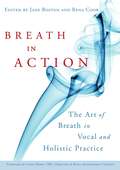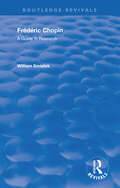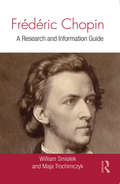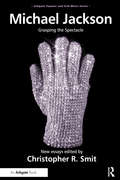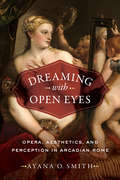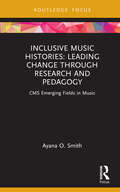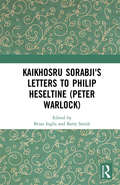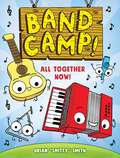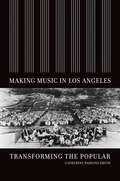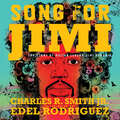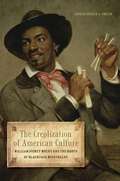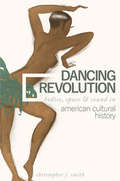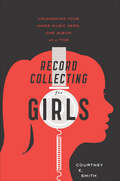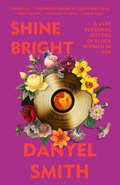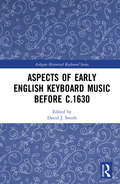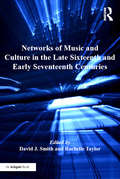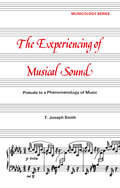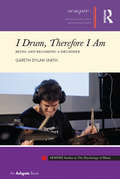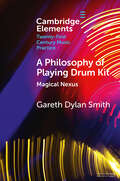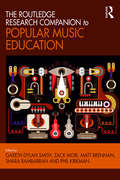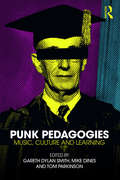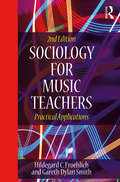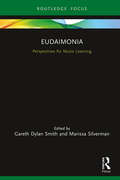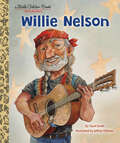- Table View
- List View
Breath in Action: The Art of Breath in Vocal and Holistic Practice
by Roger Smart David Carey Rebecca Cuthbertson Stephanie Martin Rocco Dal Vera Rena Cook Joanna Weir Ouston Katya Bloom Jane Boston Judy Lee Vivier Gillyanne Kayes Marj Mcdaid Kristin Linklater Yolanda Heman-Ackah April Pierrot Lisa Wilson Mel Churcher Cicely Berry Tara Mcallister-Viel Debbie Green Michael Morgan Jessica Wolf Floyd KennedyBreath in Action looks at the significance of breath to human life - not just the simple fact that if we stop breathing, we die, but also the more subtle ways in which our breath interacts with our voice and our being. Written by experts in vocal and holistic practice, the book is divided into four sections: Breath and the Body; Breath and the Mind; Breath and Holistic Practice; Breath and Performance. It offers the latest theories from a variety of disciplines on how we can be taught to breathe better so as to communicate better, act or sing better, feel better, live better. Combining theory with practice, many of the chapters also offer clearly laid out breathing exercises and techniques. Interdisciplinary in its focus, Breath in Action adds to specialist knowledge in the performance field, whilst also offering enlightening information for those interested in therapeutic and healing processes, movement, and voice and speech sciences.
Fredric Chopin: A Research and Information Guide
by William SmialekImportant books, articles, reviews, and theses on Fr d ric Chopin (1810-1849) in Western European languages and in Polish are cited; selected references in languages such as Russian, Czech, and Japanese are included as well. The Chopin legend is considered through studies of the performance tradition and a discography of recent and reissued recordings. Short essays outline the historiography of Chopin research and the current direction of scholarship. Index.
Frédéric Chopin: A Research and Information Guide (Routledge Music Bibliographies)
by William Smialek Maja TrochimczykFrédéric Chopin: A Research and Information Guide is an annotated bibliography concerning both the nature of primary sources related to the composer and the scope and significance of the secondary sources which deal with him, his compositions, and his influence as a composer. The second edition includes research published since the publication of the first edition and provides electronic resources.
Michael Jackson: Grasping the Spectacle (Ashgate Popular And Folk Music Ser.)
by Christopher R. SmitThroughout his 40-year career, Michael Jackson intrigued and captivated public imagination through musical ingenuity, sexual and racial spectacle, savvy publicity stunts, odd behaviours, and a seemingly apolitical (yet always political) offering of popular art. A consistent player on the public stage from the age of eight, his consciousness was no doubt shaped by his countless public appearances, both designed and serendipitous. The artefacts he left behind - music, interviews, books written by and about him, and commercial products including dolls, buttons, posters, and photographs, videos, movies - will all become data in our cultural conversation about who Michael Jackson was, who he wanted to be, who we made him to be, and why. Michael Jackson: Grasping the Spectacle includes essays that aim to understand Jackson from multiple perspectives: critical cultural theory, musicology, art history, media studies, cultural anthropology, sociology, philosophy, religious studies, literary theory, gender studies, performance studies, disability studies, film studies, and African-American studies. Intended for classroom use as well as research and general interest, this book expands our understanding both of this fascinating figure himself and of gender, sexuality, celebrity, and popular culture.
Dreaming with Open Eyes: Opera, Aesthetics, and Perception in Arcadian Rome
by Ayana O. SmithDreaming with Open Eyes examines visual symbolism in late seventeenth-century Italian opera, contextualizing the genre amid the broad ocularcentric debates emerging at the crossroads of the early modern period and the Enlightenment. Ayana O. Smith reevaluates significant aspects of the Arcadian reform aesthetic and establishes a historically informed method of opera criticism for modern scholars and interpreters. Unfolding in a narrative fashion, the text explores facets of the philosophical and literary background and concludes with close readings of text and music, using visual symbolism to create readings of gender and character in two operas: Alessandro Scarlatti's La Statira (Rome, 1690), and Carlo Francesco Pollarolo's La forza della virtù (Venice, 1693). Smith’s interdisciplinary approach enhances our modern perception of this rich and underexplored repertory, and will appeal to students and scholars not only of opera, but also of literature, philosophy, and visual and intellectual cultures.
Inclusive Music Histories: CMS Emerging Fields in Music (CMS Emerging Fields in Music)
by Ayana O. SmithInclusive Music Histories: Leading Change through Research and Pedagogy models effective practices for researchers and instructors striving either to reform music history curricula at large or update individual topics within their classes to be more inclusive. Confronting racial and other imbalances of Western music history, the author develops four core principles that enable a shift in thinking to create a truly intersectional music history narrative and provides case studies that can be directly applied in the classroom. The book addresses inclusivity issues in the discipline of musicology by outlining imbalances encoded into the canonic repertory, pedagogy, and historiography of the field. This book offers comprehensive teaching tools that instructors can use at all stages of course design, from syllabus writing and lecture planning to discussion techniques, with assignments for each of the subject matter case studies. Inclusive Music Histories enables instructors to go beyond token representation to a more nuanced music history pedagogy.
Inclusive Music Histories: CMS Emerging Fields in Music (CMS Emerging Fields in Music)
by Ayana O. SmithInclusive Music Histories: Leading Change through Research and Pedagogy models effective practices for researchers and instructors striving either to reform music history curricula at large or update individual topics within their classes to be more inclusive. Confronting racial and other imbalances of Western music history, the author develops four core principles that enable a shift in thinking to create a truly intersectional music history narrative and provides case studies that can be directly applied in the classroom. The book addresses inclusivity issues in the discipline of musicology by outlining imbalances encoded into the canonic repertory, pedagogy, and historiography of the field. This book offers comprehensive teaching tools that instructors can use at all stages of course design, from syllabus writing and lecture planning to discussion techniques, with assignments for each of the subject matter case studies. Inclusive Music Histories enables instructors to go beyond token representation to a more nuanced music history pedagogy.
Kaikhosru Sorabji's Letters to Philip Heseltine (Peter Warlock)
by Barry Smith Brian InglisTwo extraordinary personalities, and one remarkable friendship, are reflected in the unique corpus of letters from Anglo-Parsi composer-critic Kaikhosru Sorabji (1892-1988) to Philip Heseltine (Peter Warlock) (1894-1930): a fascinating primary source for the period 1913-1922 available in a complete scholarly edition for the first time. The volume also provides a new contextual, critical and interpretative framework, incorporating a myriad of perspectives: identities, social geographies, style construction, and mutual interests and influences. Pertinent period documents, including evidence of Heseltine’s reactions, enhance the sense of narrative and expand on aesthetic discussions. Through the letters’ entertaining and perceptive lens, Sorabji’s early life and compositions are vividly illuminated and Heseltine’s own intriguing life and work recontextualised. What emerges takes us beyond tropes of otherness and eccentricity to reveal a persona and a narrative with great relevance to modern-day debates on canonicity and identity, especially the nexus of ethnicity, queer identities and Western art music. Scholars, performers and admirers of early twentieth-century music in Britain, and beyond, will find this a valuable addition to the literature. The book will appeal to those studying or interested in early musical modernism and its reception; cultural life in London around and after the First World War; music, nationality and race; Commonwealth studies; and music and sexuality.
Band Camp! 1: All Together Now! (Band Camp)
by Brian "Smitty" SmithThe band is getting together in this brand-new, laugh-out-loud graphic chapter book series starring four musical instruments in their first year at Band Camp!Cordelia the accordion, Trey the triangle, Kaylee the ukulele, and Zook the kazoo meet when they're assigned to Bunk J--nicknamed "Junk Bunk" by the other instruments. Despite their differences, they'll have to become fast friends as they explore the wonders and challenges of the camp, including experiences with nature, food fights, and camp pranks. Can they learn to be in tune with each other by the time the big relay race comes around?
Making Music in Los Angeles: Transforming the Popular
by Catherine Parsons SmithIn this social history of music in Los Angeles from the 1880s to 1940, Catherine Parsons Smith ventures into an often neglected period to discover that during America's Progressive Era, L.A. was a center for making music long before it became a major metropolis. She describes the thriving music scene over some sixty years, including opera, concert giving and promotion, and the struggles of individuals who pursued music as an ideal, a career, a trade, a business--or all those things at once.
Song for Jimi: The Story of Guitar Legend Jimi Hendrix
by Charles R. SmithJimi Hendrix's talent was epic, and so is this lyrical account of his life, with spectacular artwork by Edel Rodriguez-- including a poster underneath the jacket!From his turbulent childhood through his epical appearance at the Monterey and Woodstock festivals, Charles R. Smith Jr. covers it all in this rich and rhythmic account of a singular life, accompanied by the psychedelic splendor of Edel Rodriguez's acid-tinged artwork. Let me tell you a story,a story 'bout a boy,who became a man,a git-tar man,named Jimi.Written as a series of verses beginning with intro and ending with outro, this unique mix of rhythm and rhyme captures the essence of rock icon Jimi Hendrix and his struggle to live life on his own terms. Backmatter, including a select discography, timeline of Hendrix's life, and a personal essay from the author, is included. A Kirkus Reviews Best Picture Book of the YearA CBC/NCSS Notable Social Studies Trade BookA CSMCL Best Multicultural Children's Book of the YearAn Evanston Public Library Great Books for Kids pick!
The Creolization of American Culture: William Sidney Mount and the Roots of Blackface Minstrelsy (Music in American Life)
by Christopher J SmithThe Creolization of American Culture examines the artworks, letters, sketchbooks, music collection, and biography of the painter William Sidney Mount (1807–1868) as a lens through which to see the multiethnic antebellum world that gave birth to blackface minstrelsy. As a young man living in the multiethnic working-class community of New York's Lower East Side, Mount took part in the black-white musical interchange his paintings depict. An avid musician and tune collector as well as an artist, he was the among the first to depict vernacular fiddlers, banjo players, and dancers precisely and sympathetically. His close observations and meticulous renderings provide rich evidence of performance techniques and class-inflected paths of musical apprenticeship that connected white and black practitioners. Looking closely at the bodies and instruments Mount depicts in his paintings as well as other ephemera, Christopher J. Smith traces the performance practices of African American and Anglo-European music-and-dance traditions while recovering the sounds of that world. Further, Smith uses Mount's depictions of black and white music-making to open up fresh perspectives on cross-ethnic cultural transference in Northern and urban contexts, showing how rivers, waterfronts, and other sites of interracial interaction shaped musical practices by transporting musical culture from the South to the North and back. The "Africanization" of Anglo-Celtic tunes created minstrelsy's musical "creole synthesis," a body of melodic and rhythmic vocabularies, repertoires, tunes, and musical techniques that became the foundation of American popular music. Reading Mount's renderings of black and white musicians against a background of historical sites and practices of cross-racial interaction, Smith offers a sophisticated interrogation and reinterpretation of minstrelsy, significantly broadening historical views of black-white musical exchange.
Dancing Revolution: Bodies, Space, and Sound in American Cultural History (Music in American Life)
by Christopher J. SmithThroughout American history, patterns of political intent and impact have linked the wide range of dance movements performed in public places. Groups diverse in their cultural or political identities, or in both, long ago seized on dancing in our streets, marches, open-air revival meetings, and theaters, as well as in dance halls and nightclubs, as a tool for contesting, constructing, or reinventing the social order. Dancing Revolution presents richly diverse cases studies to illuminate these patterns of movement and influence in movement and sound in the history of American public life. Christopher J. Smith spans centuries, geographies, and cultural identities as he delves into a wide range of historical moments. These include: the God-intoxicated public demonstrations of Shakers and Ghost Dancers in the First and Second Great Awakenings; creolized antebellum dance in cities from New Orleans to Bristol; the modernism and racial integration that imbued twentieth-century African American popular dance; and public movement's contributions to hip hop, anti-hegemonic protest, and other contemporary transgressive communities’ physical expressions of dissent and solidarity. Multidisciplinary and wide-ranging, Dancing Revolution examines how Americans turned the rhythms of history into the movement behind the movements.
Record Collecting For Girls: Unleashing Your Inner Music Nerd, One Album at a Time
by Courtney E. Smith“Record Collecting for Girls is an invitation for all of you stereophiles (who happen to be female), to make your own top-five lists, and then, armed and ready with the book’s fun facts, to argue their merits to the ever-present boys’ club of music snobs in your life.” —Sarahbeth Purcell, author of Love Is the Drug and This Is Not a Love SongYou never leave home without your iPod. You’re always on the lookout for new bands, and you have strong opinions when it comes to music debates, like Beatles vs. Stones. For years, you’ve listened to guys talk about all things music, but the female perspective has been missing. Until now. Drawing on her personal life as a music enthusiast, as well as her experience working at MTV and in radio, Courtney E. Smith explores what music can tell women about themselves—and the men in their lives. She takes on a range of topics, from the romantic soundtracks of Romeo and Juliet to the evolution of girl bands. She shares stories from her own life that shed light on the phenomenon of guilty pleasures and the incredible power of an Our Song. Along the way, she evaluates the essential role that music plays as we navigate life’s glorious victories and its soul-crushing defeats. Finally, here is a voice that speaks to women—because girls get their hearts broken and make mix tapes about it, too. “Courtney Smith has smarts and sass in spades. Her insights are as hilarious as they are thoughtful, and when you finish reading this book, you’ll feel like you just got home from a perfect night out with your best friend. And you’ll want to listen to Prince. At full volume.” —Megan Jasper, Executive Vice President, Sub Pop Records
Shine Bright: A Very Personal History of Black Women in Pop
by Danyel SmithAmerican pop music is arguably this country&’s greatest cultural contribution to the world, and its singular voice and virtuosity were created by a shining thread of Black women geniuses stretching back to the country&’s founding. This is their surprising, heartbreaking, soaring story—from &“one of the generation&’s greatest, most insightful, most nuanced writers in pop culture&” (Shea Serrano)&“This book is revelatory about the specific experiences of Black women in music.&”—Dawnie Walton, author of The Final Revival of Opal & Nev ONE OF THE MOST ANTICIPATED BOOKS OF 2022—Oprah Daily, Essence, Electric LitA weave of biography, criticism, and memoir, Shine Bright is Danyel Smith&’s intimate history of Black women&’s music as the foundational story of American pop. Smith has been writing this history for more than five years. But as a music fan, and then as an essayist, editor (Vibe, Billboard), and podcast host (Black Girl Songbook), she has been living this history since she was a latchkey kid listening to &“Midnight Train to Georgia&” on the family stereo. Smith&’s detailed narrative begins with Phillis Wheatley, an enslaved woman who sang her poems, and continues through the stories of Mahalia Jackson, Dionne Warwick, Aretha Franklin, Gladys Knight, and Mariah Carey, as well as the under-considered careers of Marilyn McCoo, Deniece Williams, and Jody Watley. Shine Bright is an overdue paean to musical masters whose true stories and genius have been hidden in plain sight—and the book Danyel Smith was born to write.
Aspects of Early English Keyboard Music before c.1630 (Ashgate Historical Keyboard Series)
by David J. SmithEnglish keyboard music reached an unsurpassed level of sophistication in the late sixteenth and early seventeenth centuries as organists such as William Byrd and his students took a genre associated with domestic, amateur performance and treated it as seriously as vocal music. This book draws together important research on the music, its sources and the instruments on which it was played. There are two chapters on instruments: John Koster on the use of harpsichord during the period, and Dominic Gwynn on the construction of Tudor-style organs based on the surviving evidence we have for them. This leads to a section devoted to organ performance practice in a liturgical context, in which John Harper discusses what the use of organs pitched in F may imply about their use in alternation with vocal polyphony, and Magnus Williamson explores improvisational practice in the Tudor period. The next section is on sources and repertoire, beginning with Frauke Jürgensen and Rachelle Taylor’s chapter on Clarifica me Pater settings, which grows naturally out of the consideration of improvisation in the previous chapter. The next two contributions focus on two of the most important individual manuscript sources: Tihomir Popović challenges assumptions about My Ladye Nevells Booke by reflecting on what the manuscript can tell us about aristocratic culture, and David J. Smith provides a detailed study of the famous Fitzwilliam Virginal Book. The discussion then broadens out into Pieter Dirksen’s consideration of a wider selection of sources relating to John Bull, which in turn connects closely to David Leadbetter’s work on Gibbons, lute sources and questions of style.
Networks of Music and Culture in the Late Sixteenth and Early Seventeenth Centuries: A Collection of Essays in Celebration of Peter Philips’s 450th Anniversary
by David J. Smith Rachelle TaylorPeter Philips (c.1560-1628) was an English organist, composer, priest and spy. He was embroiled in multifarious intersecting musical, social, religious and political networks linking him with some of the key international players in these spheres. Despite the undeniable quality of his music, Philips does not fit easily into an overarching, progressive view of music history in which developments taking place in centres judged by historians to be of importance are given precedence over developments elsewhere, which are dismissed as peripheral. These principal loci of musical development are given prominence over secondary ones because of their perceived significance in terms of later music. However, a consideration of the networks in which Philips was involved suggests that he was anything but at the periphery of the musical, cultural, religious and political life of his day. In this book, Philips’s life and music serve as a touchstone for a discussion of various kinds of network in the late sixteenth and early seventeenth centuries. The study of networks enriches our appreciation and understanding of musicians and the context in which they worked. The wider implication of this approach is a constructive challenge to orthodox historiographies of Western art music in the Early Modern Period.
Experiencing of Musical Sound: A Prelude to a Phenomenology of Music (Musicology)
by F. J. SmithFirst Published in 1979. Routledge is an imprint of Taylor & Francis, an informa company.
I Drum, Therefore I Am: Being and Becoming a Drummer (SEMPRE Studies in The Psychology of Music)
by Gareth Dylan SmithDespite their central role in many forms of music-making, drummers have been largely neglected in the scholarly literature on music and education. But kit drummers are increasingly difficult to ignore. While exponents of the drum kit are frequently mocked in popular culture, they are also widely acknowledged to be central to the musical success and aesthetic appeal of any musical ensemble in which they are found. Drummers are also making their presence felt in music education, with increasing opportunities to learn their craft in formal contexts. Drawing on data collected from in-depth interviews and questionnaires, Gareth Dylan Smith explores the identities, practices and learning of teenage and adult kit drummers in and around London. As a London-based drummer and teacher of drummers, Smith uses his own identity as participant-researcher to inform and interpret other drummers' accounts of their experiences. Drummers learn in multi-modal ways, usually with a keen awareness of exemplars of their art and craft. The world of kit drumming is highly masculine, which presents opportunities and challenges to drummers of both sexes. Smith proposes a new model of the 'Snowball Self', which incorporates the constructs of identity realization, learning realization, meta-identities and contextual identities. Kit drummers' identities, practices and learning are found to be intertwined, as drummers exist in a web of interdependence. Drummers drum; therefore they are, they do, and they learn - in a rich tapestry of means and contexts.
A Philosophy of Playing Drum Kit: Magical Nexus (Elements in Twenty-First Century Music Practice)
by Gareth Dylan SmithThe author is a drummer with experience in a variety of musical genres and contexts, with emphasis on rock and related styles. This auto ethnographic Element presents the author's philosophy of playing drum kit. The text explains how playing drum kit matters to this musician and may resonate with others to whom making music matters in similar ways. The Element contains audio files of music in which the author plays drum kit in the ensemble settings described. There are photos of the author's drums and of him drumming. Based on June Boyce-Tillman's non-religious model of holistic spirituality and Tim Ingold's notion of correspondences, the author describes how playing drum kit enables him to experience transcendence – the magical nexus at which Materials, Construction, Values/Culture and Expression meet. Each of these domains, and the magic derived from their combination, is illustrated through examples of the author's live and recorded musical collaborations.
The Routledge Research Companion to Popular Music Education
by Gareth Dylan Smith Matt Brennan Phil Kirkman Shara Rambarran Zack MoirPopular music is a growing presence in education, formal and otherwise, from primary school to postgraduate study. Programmes, courses and modules in popular music studies, popular music performance, songwriting and areas of music technology are becoming commonplace across higher education. Additionally, specialist pop/rock/jazz graded exam syllabi, such as RockSchool and Trinity Rock and Pop, have emerged in recent years, meaning that it is now possible for school leavers in some countries to meet university entry requirements having studied only popular music. In the context of teacher education, classroom teachers and music-specialists alike are becoming increasingly empowered to introduce popular music into their classrooms. At present, research in Popular Music Education lies at the fringes of the fields of music education, ethnomusicology, community music, cultural studies and popular music studies. The Ashgate Research Companion to Popular Music Education is the first book-length publication that brings together a diverse range of scholarship in this emerging field. Perspectives include the historical, sociological, pedagogical, musicological, axiological, reflexive, critical, philosophical and ideological.
Punk Pedagogies: Music, Culture and Learning
by Gareth Dylan Smith Mike Dines Tom ParkinsonPunk Pedagogies: Music, Culture and Learning brings together a collection of international authors to explore the possibilities, practices and implications that emerge from the union of punk and pedagogy. The punk ethos—a notoriously evasive and multifaceted beast—offers unique applications in music education and beyond, and this volume presents a breadth of interdisciplinary perspectives to challenge current thinking on how, why and where the subculture influences teaching and learning. As (punk) educators and artists, contributing authors grapple with punk’s historicity, its pervasiveness, its (dis)functionality and its messiness, making Punk Pedagogies relevant and motivating to both instructors and students with proven pedagogical practices.
Sociology for Music Teachers: Practical Applications
by Gareth Dylan Smith Hildegard C. FroehlichFor upper level undergraduate and introductory graduate and doctoral courses in music education. Outlining the basic aspects, constructs and concepts relevant to understanding music teaching and learning from a sociological perspective, this volume introduces students to the discipline as a tool in understanding their own work. The text shows how certain academics in music, sociology and education have thought about the relationship of music to education, schooling and society and examines the consequences of such thinking for making instructional choices in teaching methods and repertoire selection. School music teaching is imbedded in two major societal traditions: (1) the tradition of music making, listening, and responding; and (2) the tradition of education as a societal mandate. The first tradition holds firmly to music artistry and musicological scholarship, the latter of which includes music sociology. The second tradition, that of education as a field of study, relies mostly on pedagogical principles rooted equally in psychology and sociology. Hildegard Froehlich bases the book upon the premise that a music teacher's work is equally shaped by both traditions. The more music teachers become aware of how societal structures shape their own lives as well as the lives of their students, colleagues, and superiors; the more "reality-based" their teaching will become. Society is a composite of communities in which different social classes, groups, and reference groups co-exist-to varying degrees of compatibility due to real or perceived differences in norms and values as well as hierarchies of power. Informed or intuitive choices made by an individual indicate allegiances to particular groups, how those groups are structured hierarchically; and where and how each individual fits into those hierarchies. This is true for the music world as it is true for the world of education.
Eudaimonia: Perspectives for Music Learning (Routledge New Directions in Music Education Series)
by Gareth Dylan Smith Marissa SilvermanEudaimonia: Perspectives for Music Learning asserts the fertile applications of eudaimonia—an Aristotelian concept of human flourishing intended to explain the nature of a life well lived—for work in music learning and teaching in the 21st century. Drawing insights from within and beyond the field of music education, contributors reflect on what the "good life" means in music, highlighting issues at the core of the human experience and the heart of schooling and other educational settings. This pursuit of personal fulfillment through active engagement is considered in relation to music education as well as broader social, political, spiritual, psychological, and environmental contexts. Especially pertinent in today’s complicated and contradictory world, Eudaimonia: Perspectives for Music Learning is a concise compendium on this oft-overlooked concept, providing musicians with an understanding of an ethically-guided and socially-meaningful music-learning paradigm.
Willie Nelson: A Little Golden Book Biography (Little Golden Book)
by Geof SmithHelp your little one dream big with a Little Golden Book biography about country-music star and activist Willie Nelson! Little Golden Book biographies are the perfect introduction to nonfiction for preschoolers!Willie Nelson, singer-songwriter of such hits as "On the Road Again" and "You Were Always on My Mind," is the subject of this terrific Little Golden Book biography. Children--as well as adult fans--will be inspired by Willie's activism and work with Farm Aid and how he always stayed true to himself by dressing how he liked and creating the music he wanted to share! Look for Little Golden Book biographies about these other inspiring people:Carol BurnettHarriet TubmanLucille BallQueen Elizabeth IIBarack ObamaSonia SotomayorDr. FauciJoe BidenDolly PartonKamala HarrisMisty CopelandBetty WhiteFrida KahloRuth Bader GinsburgJackie RobinsonMartin Luther King Jr.
